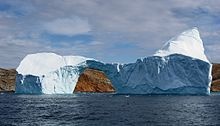Water is a transparent fluid which forms the world's streams, lakes, oceans and rain, and is the major constituent of the fluids of living things. As a chemical compound, a water molecule contains one oxygen and two hydrogen atoms that are connected bycovalent bonds. Water is a liquid at standard ambient temperature and pressure, but it often co-exists on Earth with its solid state,ice; and gaseous state, steam (water vapor). It also exists as snow, fog, dew and cloud.
Water covers 71% of the Earth's surface.[1] It is vital for all known forms of life. On Earth, 96.5% of the planet's water is found in seas and oceans, 1.7% in groundwater, 1.7% in glaciers and the ice caps of Antarctica and Greenland, a small fraction in other large water bodies, and 0.001% in the air as vapor, clouds (formed of ice and liquid water suspended in air), and precipitation.[2][3]Only 2.5% of the Earth's water is freshwater, and 98.8% of that water is in ice (excepting ice in clouds) and groundwater. Less than 0.3% of all freshwater is in rivers, lakes, and the atmosphere, and an even smaller amount of the Earth's freshwater (0.003%) is contained within biological bodies and manufactured products.[2]
Water on Earth moves continually through the water cycle of evaporation and transpiration (evapotranspiration), condensation,precipitation, and runoff, usually reaching the sea. Evaporation and transpiration contribute to the precipitation over land. Water used in the production of a good or service is known as virtual water.



